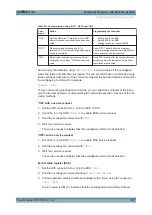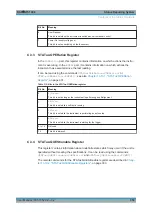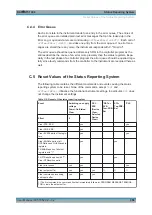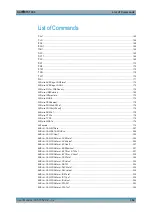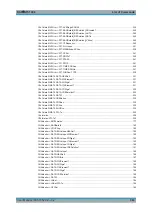
Status Reporting System
R&S
®
RTC1000
356
User Manual 1335.7352.02 ─ 02
Table C-7: Bits in the STATus:QUEStionable:LIMit register
Bit No.
Meaning
0
MEAS1
1
MEAS2
C.3.4.4
STATus:QUEStionable:MASK register
This register contains information about the violation of masks. This bit is set if the
assigned mask is violated.
Table C-8: Bits in the STATus:QUEStionable:MASK register
Bit No.
Meaning
0
MASK1
C.4 Application of the Status Reporting System
The purpose of the status reporting system is to monitor the status of one or several
devices in a measuring system. To do this and react appropriately, the controller must
receive and evaluate the information of all devices. The following standard methods
are used:
●
Service request
(SRQ) initiated by the instrument
●
Serial poll
of all devices in the bus system, initiated by the controller in order to
find out who sent a SRQ and why
●
Parallel poll
of all devices
●
Query of a
specific instrument status
by means of commands
●
Query of the
error queue
C.4.1 Service Request
Under certain circumstances, the instrument can send a service request (SRQ) to the
controller. Usually this service request initiates an interrupt at the controller, to which
the control program can react appropriately. As evident from
, an SRQ is
always initiated if one or several of bits 2, 3, 4, 5 or 7 of the status byte are set and
enabled in the SRE. Each of these bits combines the information of a further register,
the error queue or the output buffer. The
ENABle
parts of the status registers can be
set such that arbitrary bits in an arbitrary status register initiate an SRQ. In order to
make use of the possibilities of the service request effectively, all bits should be set to
"1" in enable registers SRE and ESE.
The SRQ is the only possibility for the instrument to become active on its own. Each
controller program should cause the instrument to initiate a service request if errors
occur. The program should react appropriately to the service request.
Application of the Status Reporting System






